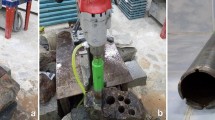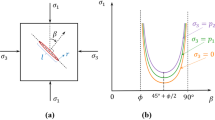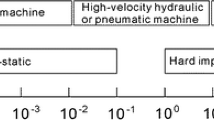Abstract
The effect of specimen size on the measured unconfined compressive strength and other mechanical properties has been studied by numerous researchers in the past, although much of this work has been based on specimens of non-standard dimensions and shapes, and over a limited size range. A review of the published literature was completed concentrating on the presentation of research pertaining to right cylindrical specimens with height:diameter ratios of 2:1. Additionally, new data has been presented considering high strength (70 MPa) cement mortar specimens of various diameters ranging from 63 to 300 mm which were tested to failure. Currently, several models exist in the published literature that seek to predict the strength–size relationship in rock or cementitious materials. Modelling the reviewed datasets, statistical analysis was used to help establish which of these models best represents the empirical evidence. The findings presented here suggest that over the range of specimen sizes explored, the MFSL (Carpinteri et al. in Mater Struct 28:311–317, 1995) model most closely predicts the strength–size relationship in rock and cementitious materials, and that a majority of the empirical evidence supports an asymptotic value in strength at large specimen diameters. Furthermore, the MFSL relationship is not only able to model monotonically decreasing strength–size relationships but is also equally applicable to monotonically increasing relationships, which although shown to be rare do for example exist in rocks with fractal distributions of hard particles.
































Similar content being viewed by others
References
ASTM (2001) Standard practices for preparing rock core specimens and determining dimensional and shape tolerances, Designation: D 4543–01. Annual Book of ASTM Standards. ASTM International, West Conshohocken
ASTM (2004) Standard test method for compressive strength and elastic moduli of intact rock core specimens under varying states of stress and temperatures, Designation: D 7012-04. Annual Book of ASTM Standards. ASTM International, West Conshohocken
ASTM (2007) Standard test method for particle-size analysis of soils, Designation: D422-63. Annual Book of ASTM Standards. ASTM International, West Conshohocken
Bazant ZP (1984) Size effect in blunt fracture: concrete rock metal. J Eng Mech (ASCE) 110:518–535
Blanks RF, Mcnamara CC (1935) Mass concrete tests in large cylinders. J Am Concr Inst 31:280–303
Brace WF (1981) The effect of size on mechanical properties of rock. Geophys Res Lett 8:651–652
Carpinteri A, Chiaia B, Ferro G (1995) Size effects on nominal tensile strength of concrete structures: multifractality of material ligaments and dimensional transition from order to disorder. Mater Struct 28:311–317
Carpinteri A, Ferro G, Monetto I (1999) Scale effects in uniaxially compressed concrete specimens. Mag Concr Res 51:217–225
Cunha AP (1990) Scale effects in rock mass. In: Cunha AP (ed) Proceeding of International Workshop on Scale Effects in Rock Masses, Balkema
Hawkins AB (1998) Aspects of rock strength. Bull Eng Geol Environ 57:17–30
Hoek E (2000) Rock engineering course notes by Evert Hoek. http://www.rocscience.com/education/hoeks_corner
Hoek E, Brown ET (1980) Underground Excavations in Rock. Institute of Mining and Metallurgy, London
Hoskins JR, Horino FG (1969) Influence of spherical head size and specimen diameters on the uniaxial compressive strength of rocks. US Department of the Interior, Bureau of Mines, Washington
Jackson R, Lau JSO (1990) The effect of specimen size on the laboratory mechanical properties of Lac du Bonnet grey gragranite. In: Cunha P (ed) Scale effects in rock masses. Balkema, Rotterdam
Mogi K (1961) The influence of the dimensions of specimens on the fracture strength of rocks. Bull Earthq Res Inst 40:175–185
Natau O, Frolich BO, Mutschler TO (1983) Recent development of the large scale triaxial test. In: ISRM Congress, Melbourne, pp A65–A74
Nishimatsu Y, Yamaguchi U, Motosugi K, Morita M (1969) The size effect and experimental error of the strength of rocks. J Min Mater Process Inst Jpn 18:1019–1025
Pells PJN (2004) On the absence of size effects for substance strength of Hawkesbury Sandstone. Aust Geomech 39:79–83
Pratt HR, Black AD, Brown WS, Brace WF (1972) The effect of specimen size on the mechanical properties of unjointed diorite. Int J Rock Mech Min Sci 9:513–529
Rey CCM-VD, Galindo MP, Velarde MAA (2001) Effects of using mean scores in regression models: an example from environmental psychology. Qual Quant 35:191–202
Symons IF (1970) The effect of size and shape of specimen upon the unconfined compressive strength of cement-stabilized materials. Mag Concr Res 22:45–50
Thuro K, Plinninger RJ, Zah S, Schutz S (2001) Scale effects in rock strength properties. Part1: Unconfined compressive test and Brazilian test. In: Rock mechanics—a challenge for society, June 3-7 2001. ISRM, Espoo, pp 169–174
Weibull W (1951) A statistical function of wide applicability. J Appl Mech 18:293–297
Yuki N, Aoto S, Yoshinaka R, Yoshihiro O, Terada M (1995) The scale and creep effect on the strength of welded tuff. In: Yoshinaka R, Kikuchi K (eds) International Workshop on Rock Foundation. Balkema, Tokyo
Acknowledgments
The authors would like to extend their thanks and appreciation to the undergraduate student Sajmir Bella for his assistance with the laboratory work associated with this project.
Author information
Authors and Affiliations
Corresponding author
Rights and permissions
About this article
Cite this article
Darlington, W.J., Ranjith, P.G. & Choi, S.K. The Effect of Specimen Size on Strength and Other Properties in Laboratory Testing of Rock and Rock-Like Cementitious Brittle Materials. Rock Mech Rock Eng 44, 513–529 (2011). https://doi.org/10.1007/s00603-011-0161-6
Received:
Accepted:
Published:
Issue Date:
DOI: https://doi.org/10.1007/s00603-011-0161-6




